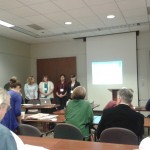Hello from Kansas everyone! I’ve been here for just over a week now at CoLang, a six-week institute on Collaborative Language research on endangered languages. I’m really excited to be here and I’ve been learning a lot in all my courses and meeting a lot of great people. The courses I took last week were XML, Lexicography, FLEx, and Grantwriting. I’m going to give a short summary of some useful things from each below. If anyone is interested in learning more about a particular topic, just let me know and I can send you notes or links!
XML: This is a formatting language that allows you to mark parts of a text as having a certain relationship to each other. You can mark the text directly, or use various programs that create this type of markup (like FLEx, see below) or format it into a particular type of output (like only the sentences in one language, or a comparison table, or a webpage, using tools like XSLT).
Lexicography: This class was all about making dictionaries. Although there are several Mi’gmaq dictionaries, it was still useful to learn about some of the decisions that dictionary-creators make and the software that can be used to do that, particularly since some of these can also be used to organize language data more generally. There’s a great list of pros and cons of various software programs in one of the presentations from the class.
FLEx: This is one popular database program that many linguists use or are familiar with. We learned how to import and backup data, how to do glossing, editing the lexicon, categorizing and linking terms with each other, and doing statistics on how many times a word occurs and in what contexts. I feel like at this point I probably know enough that I could figure out basically anything else I want to do by clicking around or reading help documents.
Grantwriting: This class was taught by two profs who were experienced in applying for grants and reviewing other people’s grants. We learned about different granting agencies and got to see some examples of both accepted and rejected grants and reviews. The most important things that they identified in grantwriting are: having a good idea, being believable that you will accomplish it, and doing so in an ethical manner (more detailed notes about how to do this that I’ll pull out in grantwriting season). Although we’ve applied to SSHRC before, there were also a few international granting agencies that I wasn’t already aware of, such as the Endangered Language Fund and the Endangered Languages Project, so these might be other things to consider at some point.
In week 2 I’m taking Archives/Databases, Strategies to Reintroduce Languages, Pedagogical Grammar, and Internet/Multimedia, which are also going well, so I’ll give a summary of those next week!



